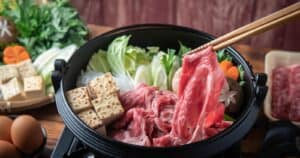The bubbling broth beckons as you gather around the hot pot, laden with uncooked ingredients. But with so many items to dip and swish, how can you tell when each one is perfectly cooked and ready to devour? Knowing when your food is done is key to hot pot success.
Undercooked food can ruin the experience, while overcooking leads to a mushy meal. Don’t worry – with a few simple tricks, you’ll know just when to retrieve those tasty morsels from the simmering pot.
Focus on visual cues and texture. Paper-thin slices of meat and seafood cook quickly, so watch for a color change. Bright vegetables should turn vibrant and glossy. Feel noodles and potatoes with chopsticks – they should be tender but still have some bite. Pay attention as you periodically sample the broth so you recognize when it absorbs maximum flavor.
With practice, you’ll soon become a hot pot cooking expert. Keep these tips in mind for your next dip-and-swish dinner so you can enjoy the communal experience of cooking and eating mouthwatering morsels, timed to perfection.
Observe Visual Cues
For thin slices of meat and seafood, look for changes in color and opacity. Beef and lamb will turn from pink to brown or grey when done. Seafood like fish and shrimp will turn opaque and white. Cooked vegetables will brighten in color – greens get more vibrant, carrots and corn grow more golden.
Judge by Texture
Use your chopsticks to periodically feel ingredients as they cook. Noodles and rice noodles should soften but still have some pleasant chewiness when ready. Potatoes will feel tender all the way through when poked. Mushrooms should feel silky, while greens like bok choy or napa cabbage will wilt.
Rely on Cooking Times
While it takes practice, learning rough cooking times will help you gauge when ingredients are nearing doneness. Very thinly sliced meat and seafood cook within 30 seconds to 1 minute. Fish balls and dumplings need 2-3 minutes. Thick slices of meat, whole shrimp and cubes of tofu will take 5-6 minutes. Hard vegetables like carrot and potato chunks may need up to 8-10 minutes.
Slice and Arrange Strategically
Cut ingredients into thin, uniform slices or small pieces so they cook at the same rate. Avoid overcrowding the pot – this slows cooking. Arrange quicker cooking items on the outer edges and larger, denser foods in the center.
Focus on One Section
Rather than trying to monitor the entire hot pot at once, pay close attention to just one section as you dip ingredients. Keep testing that area until you get the hang of judging doneness based on look and texture. Once comfortable, move on to focusing on other parts of the pot.
Spot Check as You Go
Occasionally use cooking chopsticks or a wire straining basket to grab a test piece and sample it. This helps you directly taste when something is perfectly cooked. Just be sure to use a designated utensil only for checking, not double dipping cooking tools you eat with.
Remove Items as They Finish
It’s hard to keep track of what’s done when cooked and raw ingredients pile up together. Use a slotted spoon to regularly remove cooked items into a side bowl. Emptying the pot lets you observe what still needs more time.
Start With Quick-Cooking Ingredients
Add fragile items like thinly sliced meat, fish and mushrooms only once the broth starts simmering so they don’t overcook. Have them ready in a bowl and slide them in once the pot is up to temperature.
Adjust the Heat
Keep the broth at a gentle simmer, lowering heat if it threatens to boil. Boiling can make ingredients overcook and get mushy. If the broth isn’t hot enough, ingredients won’t cook evenly.
Consider the Broth
Pay attention to how the broth evolves in flavor as you cook. The stock takes on richness and seasoning as juices from ingredients release. Time pulling ingredients so the broth is at its peak toward the end once it has absorbed maximum essence.
Don’t Overfill the Pot
Resist overloading your hot pot with food. Too many items make it challenging to monitor doneness and control cooking temperature. Cook in batches for best results.
FAQs About Determining Hot Pot Doneness
Q: How can I tell if meat is undercooked?
A: If thinly sliced meat still has a raw, pinkish hue or firm, chewy texture, it likely needs more time in the hot pot. Cook meat slices for 1-2 minutes longer until they turn brown or gray and feel soft when poked.
Q: What if my vegetables are overcooked and mushy?
A: Overcooked veggies often look drab, transparent and very soft. Try cutting vegetables into smaller, uniform pieces and cooking them in batches next time – this makes it easier to monitor and remove them before they get mushy.
Q: Should I pull everything out at once?
A: It’s best to remove each ingredient as it finishes cooking rather than pulling everything at the same time. Things cook at different rates, so plucking them individually helps avoid under or overcooking.
Q: How can I speed up cooking if needed?
A: If ingredients are taking too long, try cutting them into thinner slices, bringing the broth to a slightly harder simmer, or moving items closer to the center of the pot where it’s hottest.
Q: What’s the best hot pot broth temperature?
A: A gentle simmer between 180-210°F is ideal. This keeps the broth hot enough to cook without boiling. Check with a thermometer and adjust the heat as needed to stay in this zone.
With practice, your hot pot cooking skills will improve. You’ll learn to rely on cues like color, texture, timing and broth flavor to recognize when ingredients are perfectly done. Mastering this results in the ideal hot pot experience of dipping, swishing and eating ingredients cooked to tender, mouthwatering perfection.





